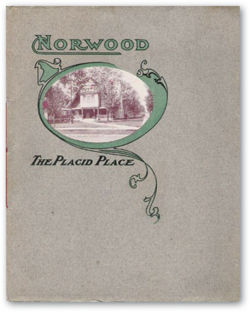Norwood
Norwood is a neighborhood of Birmingham in the Northside community, in the "North Highlands" north of downtown.
Norwood was developed by the Birmingham Realty Company beginning in 1910 with B. B. Merriweather as lead surveyor. It was named for Stanley Norwood, a friend of Birmingham Realty president Leslie Fullenweider (no doubt also chosen for its marketing potential). The neighborhood was planned as a streetcar suburb centered on Norwood Boulevard, along the same lines as the development around Highland Avenue in Southside. The central 1.5-mile boulevard's 200-foot right of way included space for the Norwood Streetcar Line as well as broad landscaped park-like medians.
Billed as "The Placid Place", the developers touted the neighborhood's convenience to downtown as well as its removal from the smoke and noise of the city center. Other amenities promised by the marketers included "gracious neighbors", fully integrated utility services, and modern architecture. Houses sprang up along the boulevard almost before it was completed, including "Tennessee Row", a group of homes built by families hailing from Tennessee.
As large houses were being constructed on the boulevard, other development followed. The Realty Company erected a commercial building with a grocery store, meat market and dairy. The neighborhood was chosen by Charles Carraway in 1916 as the site for what came to be known as Norwood Hospital before it was renamed for him. In 1925 the Norwood School was constructed.
Nevertheless, the beginnings of the neighborhood's slow, steady decline began in the 1930s as automobile ownership made it possible for affluent families to move out of Jones Valley altogether. The developers of Mountain Brook and other "Over the Mountain" suburbs advertised larger homesites absolutely free from the smoke and haze of the city. Cheaper cars and social insecurity in the wake of school integration combined to spur white flight from Birmingham after World War II. In 1968 the construction of I-20/59 through downtown severed Norwood from the city center, furthering its decline.
In recent years young homebuyers have mounted a renewal of the neighborhood, newly-appreciated for its architectural quality and convenience to downtown. In 2006 students from the Auburn University Urban Studio met with the Norwood Neighborhood Association to prepare a long-range comprehensive physical plan for the area.
A Norwood Resource Center was established in the Robert Nygren residence to assist homeowners with restoring and maintaining the neighborhood's historic architecture. The center also offers internet access, health and financial counseling and other programs for residents.
References
- Kemp, Kathy (January 29, 2006) "Reviving grandeur: Once-elegant northside neighborhood attracts renovating newcomers." Birmingham News
- Kemp, Kathy (September 9, 2007) "Old houses, new hope in Norwood." Birmingham News
- Ruisi, Anne (June 24, 2009) "Committee in Birmingham's historic Norwood Neighborhood hangs banners at community entrances." Birmingham News
External links
- Historic Norwood website
